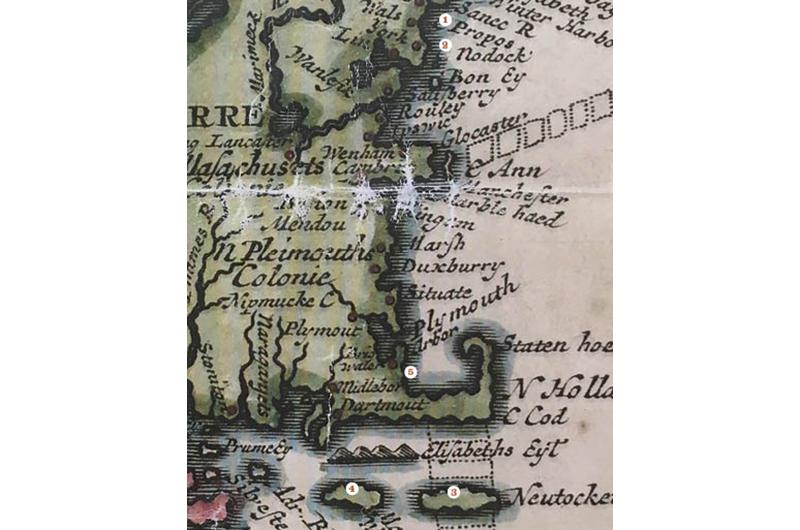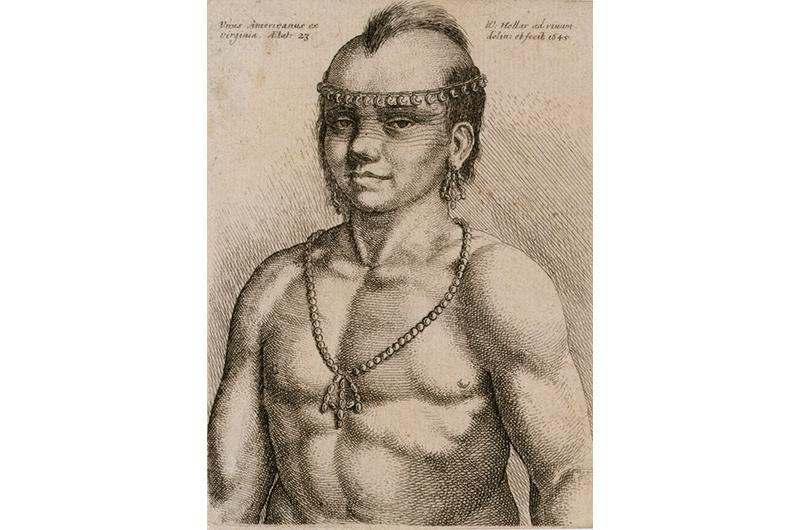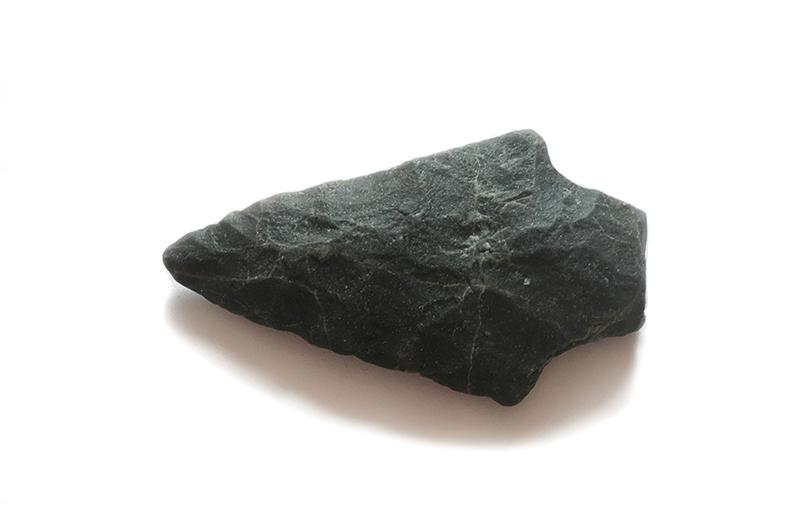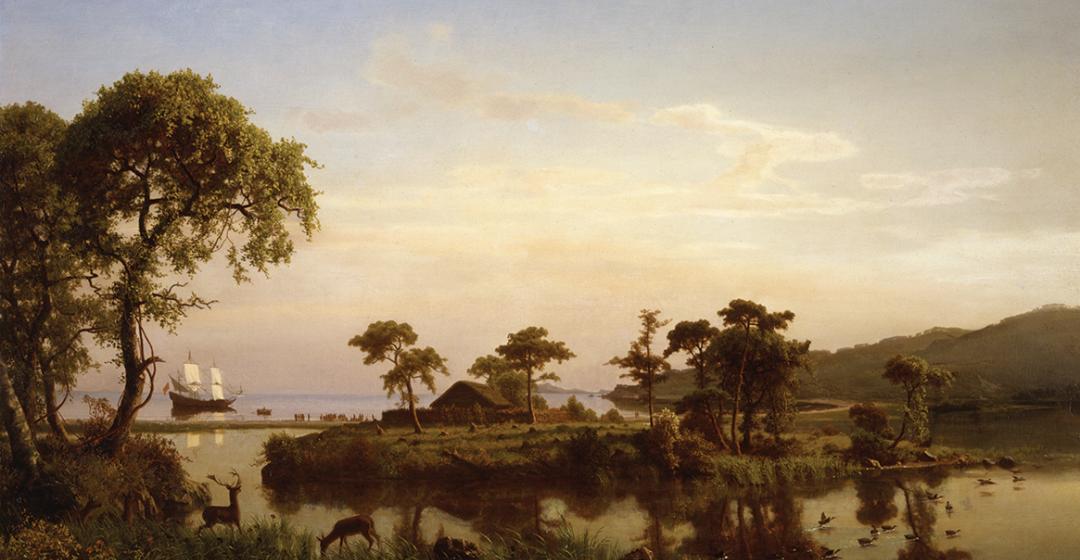The history of Noepe, the island also known as Martha’s Vineyard, stretches back thousands of years. But the earliest Islander we know by name, Epenow, lived a mere 400 years ago. Local Wampanoag tribal members and history buffs are no doubt familiar with the Indigenous man described as a tall fellow, “strong and well proportioned,” and “sober in his demeanor.” But to most, Epenow is an obscure figure compared with his legendary contemporaries Pocahontas, Squanto, and Massasoit.
His modest renown began with the events of a summer day in 1611, when the English explorer Edward Harlow anchored his ship off Noepe. Harlow was on a slave-raiding mission. He had already stolen several men from the Maine coast and Nantucket over the previous days. Once arrived at the Vineyard, Harlow abducted Epenow and at least one other Islander. Epenow and the other enslaved men were at the beginning of an epic ocean-spanning journey to England and, in a few cases, home again.
Though Epenow’s odyssey puts a spotlight on the English practice of enslaving Native Americans during the years before the first importation of enslaved Africans to Virginia in 1619, unlike most Black people enslaved by Europeans at the time, his status as a slave was not permanent or passed on to his children. That said, the habit of earlier historians calling him a “captive” or “prisoner” and not a “slave” overlooks the fact that the sailors had not seized him for a ransom or as a punishment.
Explorers like Harlow believed that Native labor could not be won with mere persuasion. So they used force instead. Capturing Native Americans was a means of creating a cadre of translators and pilots to assist them in further voyages. This habit of turning Indigenous men into shipboard slaves – which neither began nor ended with Harlow – would prove crucial to later colonists’ successes and failures. Most notable perhaps is the role of another Wampanoag slave, Tisquantum (better known as Squanto), who helped ensure the survival of the English colony at what became Plymouth, Massachusetts, in 1621 by facilitating the colony’s alliance with Massasoit and the Wampanoags of the mainland.

Epenow’s less well known story, on the other hand, runs diametrically counter to that story. It is instead an example of how the practice of enslaving Indigenous people could also backfire for the English. As such, it helps us better understand that in years when New England was still very new, not everyone in the Wampanoag world welcomed the newcomers with feasts and promises of friendship.
Ever since he was a child, Epenow no doubt heard elders tell stories of faint apparitions, strangers who haunted the coast. The visitors brought things with them: glass beads, mirrors, knives, coins, bells, copper, or pieces of fabric. With these goods came stories, surreal yarns about “great canoes” and “floating islands” that only appeared in the summer months. The visitors came in impossibly large canoes, had faces that grew fur, wore curiously woven fabrics, and brandished sticks that shot thunder. And sometimes they stole men away.
These oral traditions combined memories of multiple European visits near Wampanoag homelands in the sixteenth century, as a parade of explorers came poking around the coast and fishermen working the Grand Banks sometimes reprovisioned their ships with water and timber well north, in spots that are now part of Atlantic Canada and Maine. But those were sporadic and distant events, so the stories told by Noepe residents were probably secondhand. Though members of Bartholomew Gosnold’s 1602 expedition to the region bestowed the name Martha’s Vineyard on the Island and may have spent a few hours on shore, Harlow’s raid in 1611 was probably the first significant contact between Islanders and Europeans.
As Gosnold’s unsuccessful attempt to create a permanent outpost on nearby Cuttyhunk attests, the strangers crept nearer in Epenow’s early adolescence. The explorers Martin Pring and Samuel de Champlain both made landfall around Cape Cod Bay in 1603 and 1605, respectively. Some of these encounters with the newcomers could be downright fun. The pink-faced men made music, shared food, and smoked tobacco with the people of Patuxet (now Plymouth), Cummaquid (Barnstable), and Pamet (Provincetown).
These guests could also, however, overstay their welcome. After a few weeks in Pamet, Champlain’s men triggered a nasty fight with the town’s Native population by stealing their crops. In the melée, the Frenchmen took one man hostage, and the Pamet villagers retaliated by killing a French sailor. As Champlain’s crew sailed away, they saw column after column of smoke rising from the coastline, as tales of their deeds traveled from village to village.

That same summer of 1605, a different ship full of sailors arrived in a rugged region to the north called Mawóoshen, today the central coast of Maine. Their ship was the Archangel, and the captain was George Waymouth. Backed by merchants from Plymouth, England, Waymouth was scouting sites for a new colony, which would become the first whole-hearted English attempt to overwinter in America since the Roanoke colonists mysteriously vanished in 1590.
After a few days of peaceful engagements with a local group of eastern Abenakis, Waymouth’s men “suddenly laid hands upon” five men. Holding the captives by their hair, they dragged them into a rowboat back to the waiting ship. According to Waymouth, their abduction was “a matter of great importance for the full accomplement of our voyage.” Though the enslaved men were terrified at first, Waymouth claimed they quickly accepted their lot, behaving “very tractable, loving, & willing by their best means to satisfie us in any thing we demand of them, by words and signes for their understanding.”
Among those five was a future friend to Epenow, a man named Sassacomoit, who would remain a slave for the next nine years. When the Archangel returned to England, Waymouth handed over the captured men to two colonial promoters: Sir John Popham, then the lord chief justice of England, and Sir Ferdinando Gorges, a military man based in Plymouth, England. Upon hearing the descriptions of their home, and being impressed by the cooperative attitude of the five men, Gorges and Popham started planning a return voyage to get a proper colony up and running.
In 1607, two ships with the Indigenous guides split between them set courses back to the Maine coast to begin a colony at the Abenaki place called Sagadahoc. Only one ship made it. Sassacomoit was aboard the other vessel, which took a southern route and ended up near Florida. There they were ambushed by Spanish pirates. In the scuffle, the raiders severely beat Sassacomoit and ran a spear through his arm. The Spaniards brought their prisoners back to Spain. One of the Native men died in a prison in Cádiz, while the wounded Sassacomoit was redeemed along with his fellow crew members, and sent to live with Gorges in England, where he stayed for the next six years.
Gorges and Popham’s colony at Sagadahoc was also a bust. The settlement lasted less than a year. The hundred and twenty settlers were a factious group, undermined by constant infighting, and weakened by the departure of one leader and death of another. Perhaps even more important, having been returned home, the formerly enslaved Native Americans were no longer eager to help. The three Native men “that came out of England” soon became the incipient colony’s main antagonists, discouraging other Abenakis from trading with the English while favoring an alliance with the French.

The final nail in the colony’s coffin was the unusually cold winter of 1607–1608. It was a winter so frigid that it even stood out in the period known as “the Little Ice Age,” an era of global cooling that had been underway for over a century. It would give the whole region a bad reputation for “being over cold,” and lead Gorges to lament that “all our former hopes [were] frozen to death.” Neither the climate nor their carefully groomed assistants would obey their will. As Gorges put it, Sagadahoc became “a wonderfull discouragement” for future ventures.
Meanwhile on Noepe, years passed without any visit from ships. Finally, in 1611, Captain Harlow, the man who became Epenow’s first captor, rounded Cape Pogue and entered Nantucket Sound, likely making landfall near the present site of Vineyard Haven. Details about this captain and his voyage are scarce. Harlow or one of his crew penned an account, but no one ever got around to printing it. The manuscript has since been lost. However, we know that Harlow was an alumni of the failed Sagadahoc venture. That experience seemingly colored his feelings toward Native Americans, whom he set about aggressively capturing in several spots before snaring Epenow as a slave.
Aboard Harlow’s vessel, the two captured on Noepe met a fellow Wampanoag from Nantucket named Sakaweston and two Abenakis named Pekenimme and Monopet. Some of the other abducted men, including the other unnamed man from Noepe, likely died in transit or soon after their arrival in London, a not-uncommon fate for Native Americans arriving in the germy cities of Europe. One of the enslaved men might have lived out his days on the European continent. According to one source, Sakaweston lived in England for several years and eventually became a mercenary soldier in “the warres of Bohemia.”
By the time Harlow returned with his cargo of slaves, some English had started to sour on the idea of founding new colonies. Not only were they remembering how badly things went at Sagadahoc, but the four-year-old colony at Jamestown was in a sorry state, and only just beginning to recover from its desperate early starving years. With no one willing to enlist this new batch of slaves as guides for upcoming voyages, the captured men were little more than additional mouths to feed. Mystified at what to do with him, his masters decided Epenow’s unusual height and impressive physique offered “the last and best use they could make of him,” and they lent him out to be “shown in London as a wonder.” In his brief career as a stage performer, Epenow’s act was a simple one: he had learned enough English “as to bid those that wondered at him, ‘Welcome, welcome.’”
Native Americans were becoming a familiar sight in London. William Shakespeare mentioned the display of Indigenous men as novelties in both The Tempest and Henry VIII. The latter was first performed not long after Epenow arrived on the Thames, which has led some scholars to suspect it was the lanky Wampanoag from Noepe of whom Shakespeare was thinking. However, seeing as nearly two dozen other Americans had appeared as “wonders” in the capital by that date, we cannot say with any confidence that Epenow was the true subject of the Bard’s pen.

While European crowds would gather to gawk at “Indians” again and again for centuries to come, Epenow’s simple gimmick of merely greeting passers-by had soon “growne out of the peoples wonder.” With his short career in show business over, he was sent from London down to Plymouth, England, where he met Sassacomoit, the Abenaki captive who had his arm mangled by Spanish pirates. The two got to talking, but not without some difficulty as they spoke related but distinct Algonquian languages.
In Plymouth, Epenow was under the supervision of Gorges, who was, with his fellow entrepreneur Nicholas Hobson, still dreaming of finding untold riches in New England even though by the year 1614, “adventurers of that kind were worne out of date.” They must have mentioned their near-obsessive interest in a soft, yellowish metal so often that Epenow hatched an idea. It was a simple plan, one that he almost certainly concocted with the help of his fellow bondsman Sassacomoit. Epenow proposed that he could “conduct the adventurers to a gold mine” on his home island. The prospect was too irresistible for the adventurers to pass up, and they began outfitting a ship.
The English vessel carrying Epenow, Sassacomoit, and a couple of other previously captured Native Americans arrived off the American coast in 1614, where “they were Piloted from place to place by the Natives themselves as well as their hearts could desire.” When they arrived at Noepe, a party of Epenow’s “Brothers” and “Couzens” met the ship with great celebration. The English crew “kindly entertained” the captive and his kinsmen while they “communed” in their mother tongue.
The locals left with cheerful promises to return the next day and show the way to gold, but it began to strike the captors that perhaps they were about to be had. They suspected “Epenow privately (as it appeared) had contracted with his friends, how he might make his escape.” Hoping “by all meanes to prevent his escapeing,” the sailors dressed Epenow in a long-sleeved shirt and pants to make it easier to restrain him “if occasion should require.”
Despite these precautions, the next day a fleet of twenty canoes closed in rapidly on the anchored ship, alarming the English crew. After a brief struggle, Epenow freed himself and slipped overboard. As the prized captive splashed into the water, “the Natives sent such a showre of arrowes, and came withall desperately so neer the Ship that they carryed him away in despight of all the Musquetteers aboard.” Dodging whistling arrows, and wildly firing shots in the air, the Englishmen watched helplessly as Epenow and their dreams of a gold mine disappeared across the water.

Not everyone on the ship was necessarily crestfallen. Epenow’s friend Sassacomoit and the other Native Americans on deck must have known about the plot all along. We can only imagine Epenow’s first steps ashore, when he triumphantly shed the soaking “long garments” that had failed to restrain him, congratulated his fellow Islanders on their daring rescue, and cursed the men whose own greed for nonexistent gold had whisked him home.
A few days later, without any trickery, Sassacomoit also had a safe return to the Maine coast. A whole nine years had passed since Waymouth took him captive and he no doubt appeared a changed man. He’d crossed the Atlantic four times, become fluent in English, and survived pirates, prison, and a near fatal wound. As he disembarked from the ship, he also departed the historical record, as colonists made no further mention of him. One imagines that as he lived out his days, he enjoyed telling tales of his adventures and describing the places he’d been: Florida, Cádiz, London, and Plymouth.
We know for sure that Epenow enjoyed telling the tale of his redemption. Five years later, in 1619, when the explorer Thomas Dermer visited Noepe he “met with Epinew a Sauage that had lived in England, and speakes indifferent good English.” “With him I had much conference,” Dermer recalled, as the former captive “laughed at his own escape, and reported the story of it” with obvious satisfaction.
Listening to the humorous tale with Dermer was another former slave who was serving as translator and guide: Tisquantum (Squanto). Hailing from the village of Patuxet, on Cape Cod Bay, Tisquantum and some twenty-five of his countrymen had been captured by the English fisherman Thomas Hunt in 1614, at almost the same time that Epenow regained his freedom. Over the next half decade, he experienced a journey that was easily as colorful as Sassacomoit’s: from Patuxet to Málaga, Spain, to London, to Newfoundland, and home again. But his return brought an awful shock. He and Dermer found Patuxet abandoned as a result of an epidemic that had swept over Wampanoag country, killing thousands. It had wiped out several other Massachusett and Wampanoag towns, and the few survivors had fled to communities where they had kinfolk.
Despite their parallel experiences, there was no apparent warmth between Tisquantum and Epenow. When Tisquantum and Dermer returned to Noepe a year later, Epenow was no longer in such a jovial mood. Still nursing a deep and understandable grudge toward Englishmen, he ended up in a skirmish with Dermer and Tisquantum, which ended with Dermer mortally wounded and Tisquantum once again being taken captive, this time by his fellow Wampanoags. Epenow dispatched him to the Pokanoket Wampanoag sachem Ousamequin, better known to posterity as Massasoit. Months later, a weathered wine-hauling ship named Mayflower arrived at Patuxet packed with passengers, which would begin a whole new chapter in Tisquantum’s life, a familiar tale that need not be recited here.

The mythology that grew up around the Plymouth colonists usually portrays the bilingual Tisquantum as a unique and almost miraculous figure, but the mere existence of Epenow and Sassacomoit suggests otherwise. In fact, English, French, and Dutch sailors ultimately enslaved more than fifty Indigenous men from more than a dozen different locations along the coast of New England. The majority never returned home: they either died in the ocean passage or in Europe.
Almost every survivor we can account for made getting home their highest priority. Most also subtly (and not-so-subtly) manipulated English adventurers to these ends. As far as we have records, the slaves who regained their freedom upon return uniformly had negative or ambiguous feelings toward Europeans. Even Tisquantum, the so-called “friend of the Pilgrims,” revealed himself to be more concerned with the world of Native politics than with helping the colonists.
The events of Epenow’s life and the many men like him do not as easily fit into a narrative of American origins as the recently commemorated events of 1619 and 1620. Contrary to the myth of the “helpful Indian” whose purpose in life was to help colonies succeed – a trope that still shapes how Americans remember Squanto and Pocahontas, both of whom were also initially enslaved by colonists – the man from Noepe had no interest in beginning the world anew. He simply wanted to be free.




 1 comment
1 comment
Comments (1)